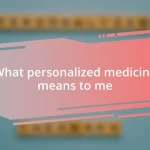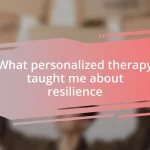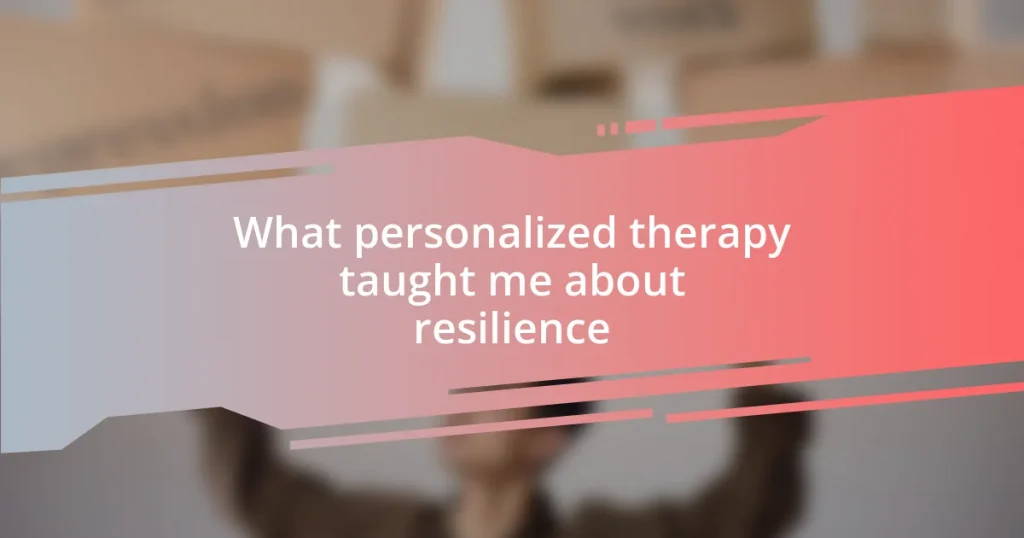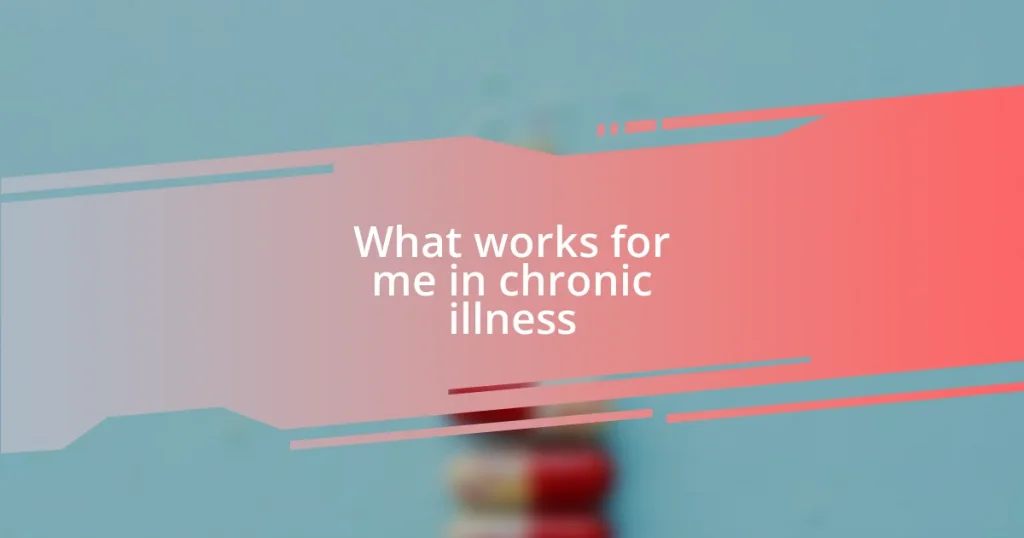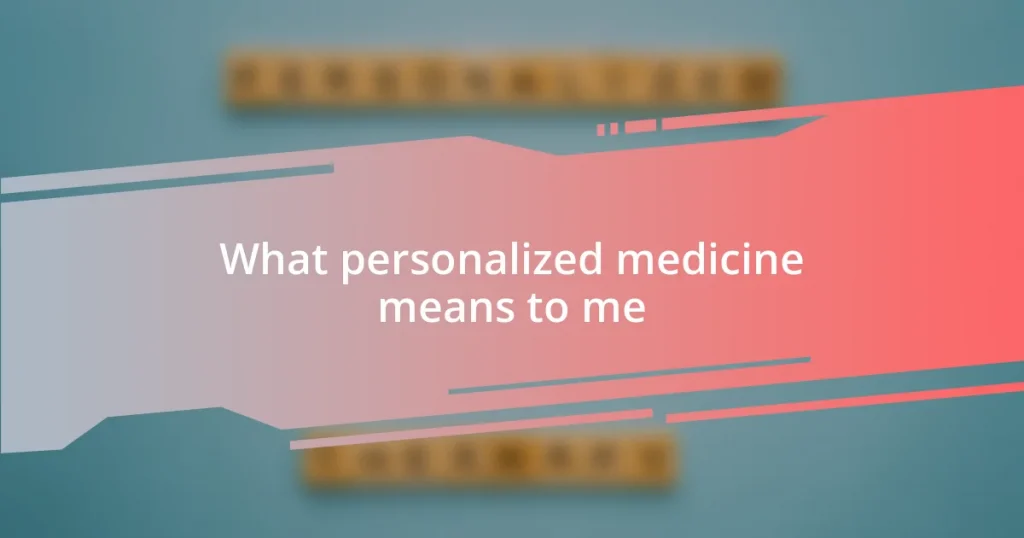Key takeaways:
- Personalized therapy is a collaborative process that tailors approaches to individual needs, enhancing engagement and resilience.
- Key concepts of resilience include adaptability, growth from challenges, and the importance of social support for emotional strength.
- Practicing gratitude, setting small goals, and embracing vulnerability are essential techniques for building resilience in daily life.
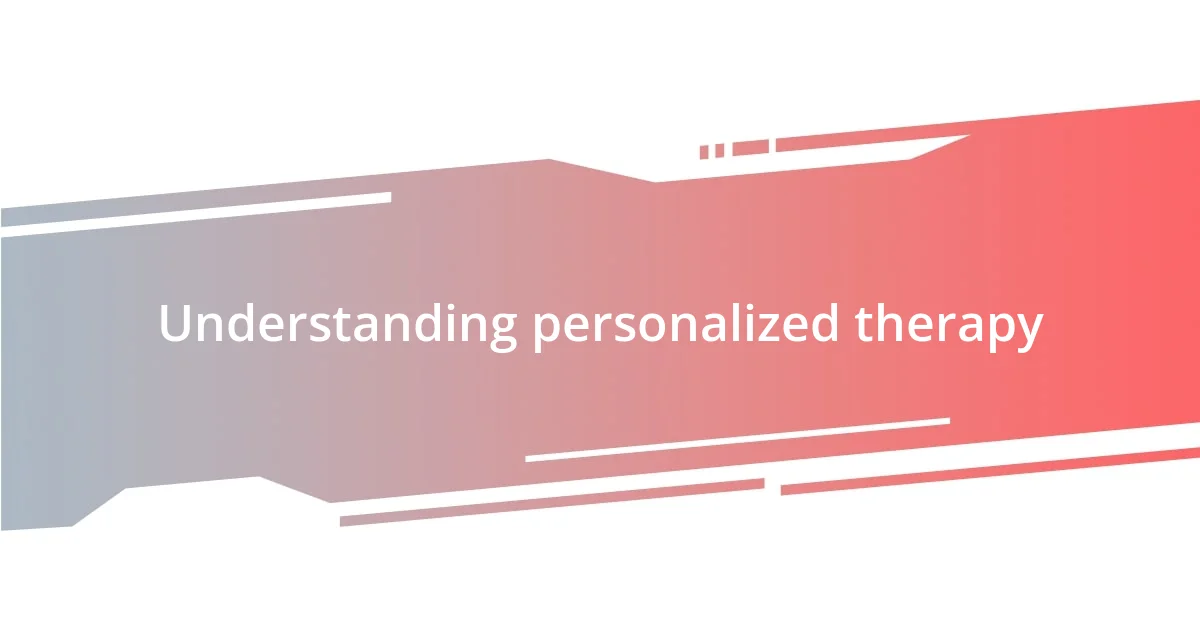
Understanding personalized therapy
Personalized therapy, in essence, tailors the therapeutic process to each individual’s unique experiences, needs, and preferences. I remember my first session; my therapist asked me about my background and what I hoped to gain from therapy. How could she design a roadmap to resilience without knowing my story?
One of the most striking aspects of personalized therapy is how it actively engages you in the healing process. I learned that we’re not just passive recipients of therapy; we’re co-creators of our journey. This realization was empowering—I felt like I had a hand in my own healing, which changed my outlook dramatically.
It’s remarkable how specific approaches, like cognitive-behavioral techniques or mindfulness strategies, can be customized to suit our individual lives. For instance, my therapist suggested daily affirmations tailored to my struggles with anxiety. Did it feel strange at first? Absolutely! But seeing their impact on my thoughts and behaviors illustrated just how effective personalization in therapy can truly be.
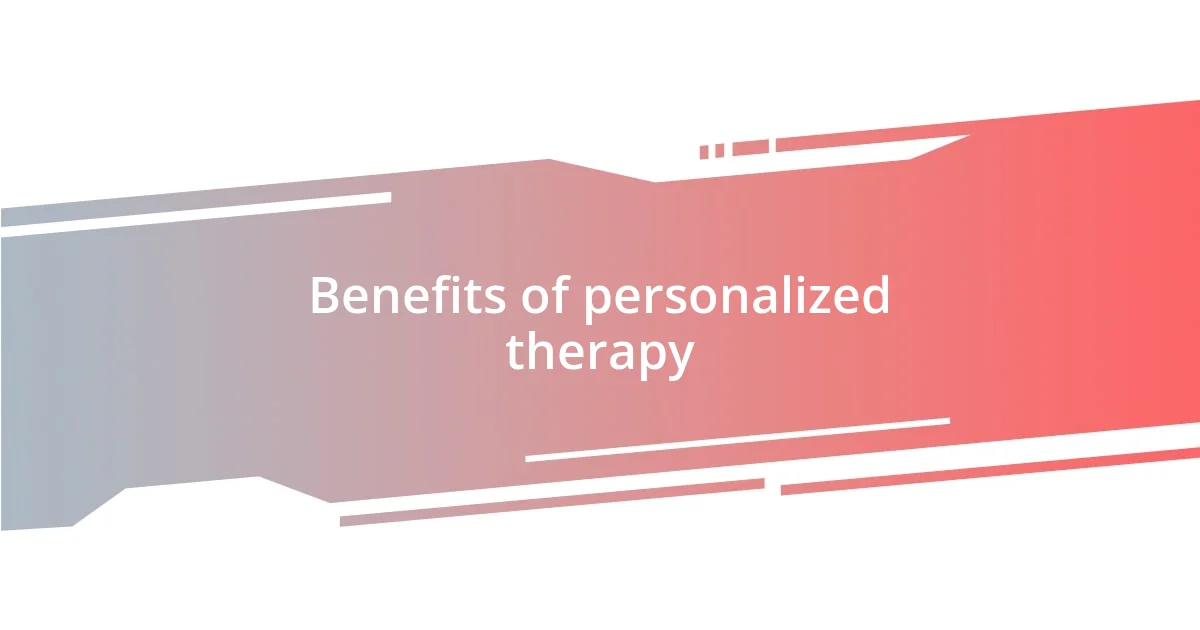
Benefits of personalized therapy
Personalized therapy offers an array of benefits that can significantly enhance one’s healing journey. For instance, the tailored approach fosters a deeper connection between the therapist and the client, allowing for trust to blossom. During my sessions, I often felt seen and understood—it’s as if my therapist was able to navigate my intricate emotional landscape with precision. This not only heightened my sense of safety but also made me more willing to explore challenging themes within myself.
- Enhanced Engagement: The process becomes a collaborative effort, making me an active participant in my healing.
- Tailored Strategies: Specific techniques, like journaling prompts that resonated with my experiences, provide a personalized touch that standard methods often lack.
- Deepened Insight: A focused approach allows for profound insights and realizations that can change one’s perspective on personal challenges.
- Increased Motivation: Knowing that the therapy was designed just for me ignited a stronger motivation to tackle my hurdles head-on.
- Greater Resilience: Each small victory in therapy built my resilience, empowering me to face life’s obstacles with newfound strength.
The beauty of personalized therapy is in its capacity to adapt alongside me as I evolved in my understanding and coping mechanisms. There were days I felt overwhelmed, yet my therapist could recalibrate our sessions, shifting strategies to meet me where I was right then. This flexibility made it feel like I had a safety net, encouraging me to take risks in my healing process, knowing there was a support system tailored to my unique journey.
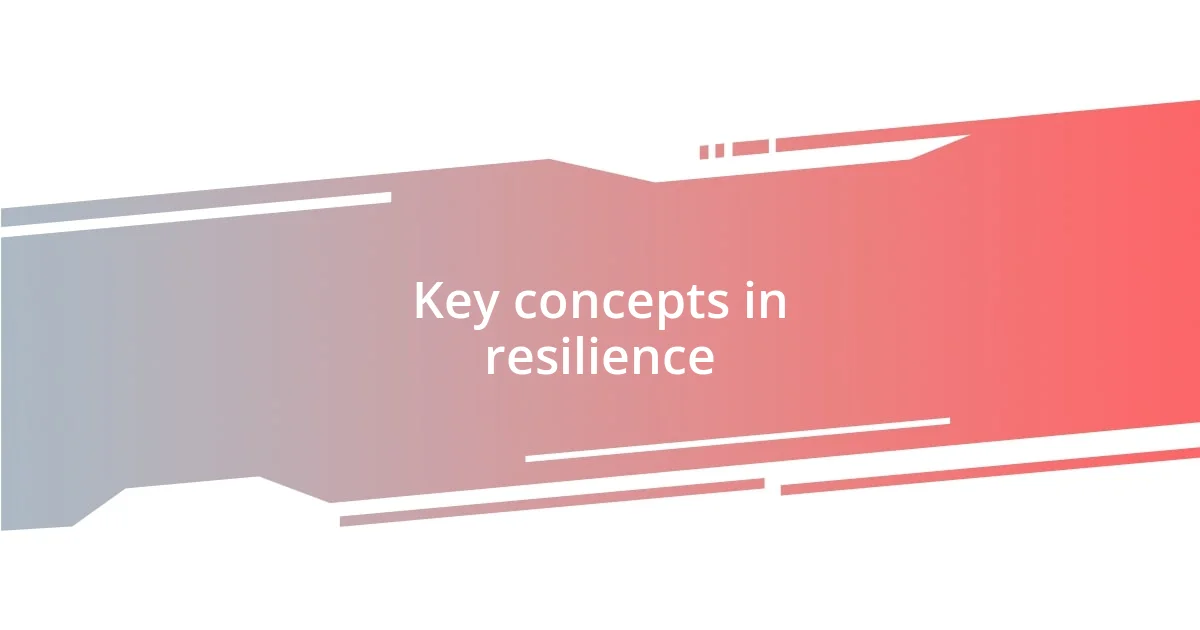
Key concepts in resilience
Resilience is often defined by our ability to bounce back from adversity, but there’s so much more to it. For me, it became clear during therapy that resilience is layered; it’s not just about recovery but about growth. There was a moment in therapy when I recognized that my struggles were not just obstacles but also opportunities for me to build my resilience. It was almost like a revelation—the idea that each challenge could help strengthen my emotional muscles.
Another key concept is adaptability. I often found myself in situations that tested my limits. During those times, my therapist introduced me to mindfulness techniques, which helped me stay present rather than getting swept away by anxiety or despair. By learning to adjust my thoughts and responses in real-time, I discovered a new level of flexibility in how I approached life’s challenges.
Finally, social support plays a significant role in resilience. I remember discussing the importance of my relationships during one of our sessions. My therapist encouraged me to lean on friends and family. When I started reaching out, I was surprised by the strength I gained from community. Sharing my experiences not only lightened my burden but also fostered deeper connections that reinforced my resilience.
| Key Concept | Description |
|---|---|
| Bouncing back | Resilience is about recovery, but also about personal growth through challenges. |
| Adaptability | Developing flexibility in thoughts and responses helps navigate difficult situations more effectively. |
| Social Support | Strong relationships enhance resilience, providing emotional and practical support during tough times. |
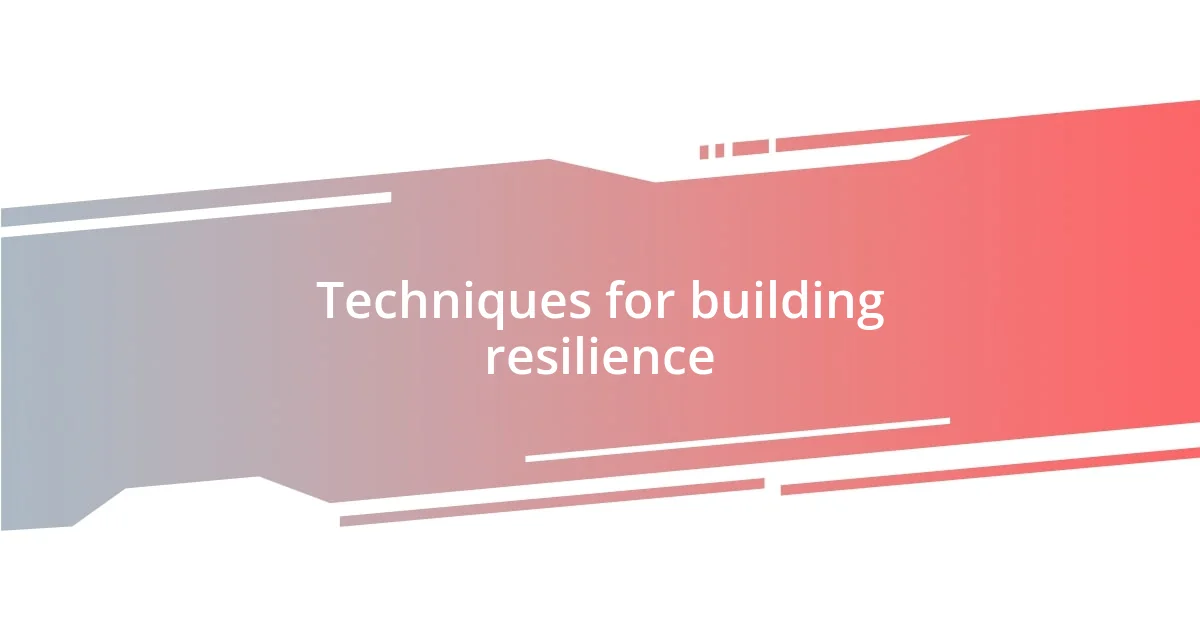
Techniques for building resilience
To build resilience, I discovered that practicing gratitude can be transformative. Each day, I began to jot down three things I was thankful for. This simple act shifted my focus from what was going wrong in my life to the moments of joy, however small. It was a profound reminder that even during tough times, there are glimmers of positivity. Have you ever paused to reflect on what you appreciate? It’s remarkable how this perspective can fortify your emotional foundation.
Another technique that profoundly impacted me was setting small, achievable goals. I remember when I was feeling particularly overwhelmed; my therapist suggested breaking down my tasks into bite-sized pieces. For instance, rather than tackling an entire project in one go, I focused on completing one section at a time. This approach not only lessened my anxiety but also gave me a sense of accomplishment with each small victory. It’s incredible how these little steps can add up and accelerate your resilience journey, don’t you think?
Lastly, I learned the importance of self-compassion. There were moments when I was my harshest critic, berating myself for not handling situations perfectly. Through therapy, I began to accept my imperfections and treat myself with the same kindness I would offer a friend. A quote that resonated with me was, “You’re doing the best you can.” This shift in mindset allowed me to forgive myself for missteps, cultivating a nurturing space that empowered me to bounce back even stronger. After all, isn’t resilience also about learning to be okay with being human?
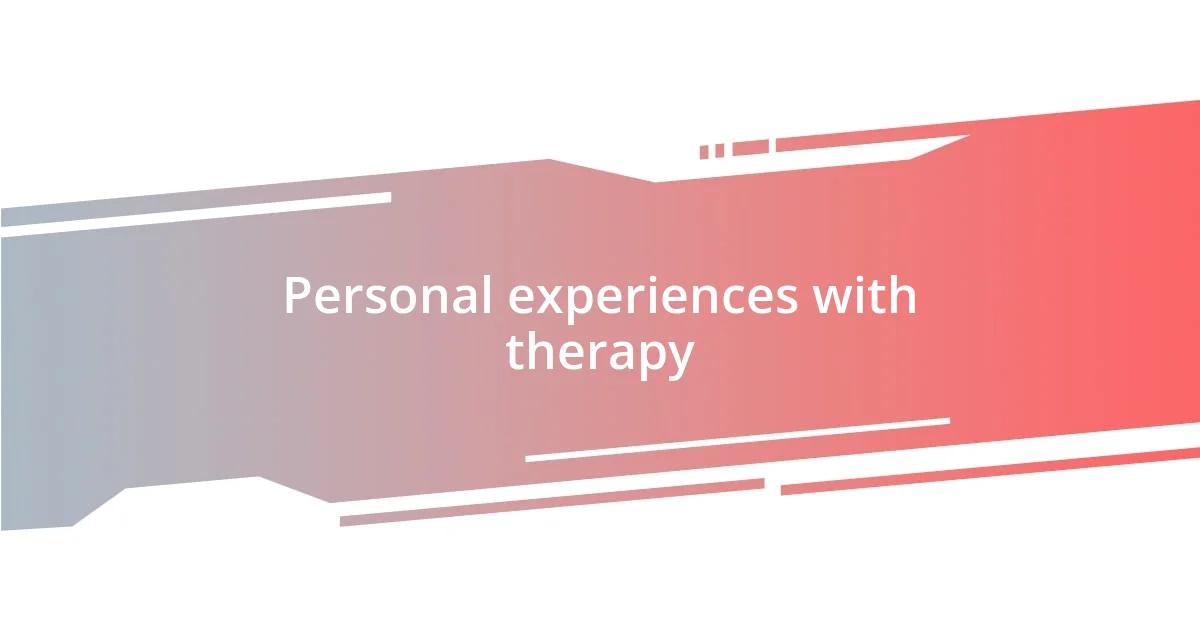
Personal experiences with therapy
Therapy has been a journey of self-discovery for me. I remember sitting in those sessions, often feeling vulnerable yet oddly safe. My therapist would pose questions that ignited deep reflection, leading me to uncover thoughts and feelings I hadn’t even acknowledged. It was in these moments that I realized therapy was a space for me to explore my resilience in a supportive light.
One session stands out vividly. After sharing a particularly tough week, I felt overwhelmed by my emotions. My therapist encouraged me to visualize my feelings as weather patterns, recognizing that storms—though intense—eventually pass. This metaphor resonated with me; it helped me compartmentalize my struggles, reminding me that bad days don’t define me. Have you ever tried to visualize your emotions? It can shift your perspective dramatically.
In another instance, we delved deep into my core beliefs. I discovered that I had internalized the notion that seeking help meant weakness. During that conversation, I felt a surge of empowerment when I began to reframe this belief. I learned that asking for support is a testament to strength and resilience, not a sign of failure. This realization changed how I interact with others, encouraging me to open up and connect more deeply. Isn’t it liberating to let go of misconceptions about vulnerability? Each step in therapy has taught me that resilience is as much about embracing our struggles as it is about celebrating our growth.
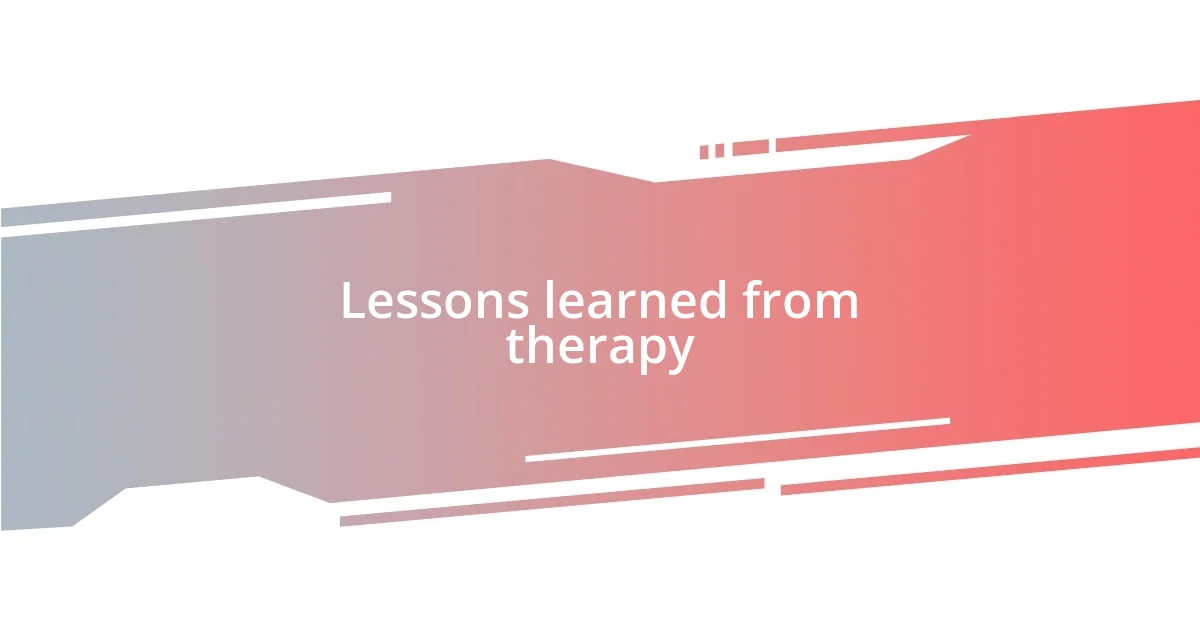
Lessons learned from therapy
Therapy taught me that emotional awareness is crucial for resilience. I vividly remember a session where I was caught in a whirlwind of feelings, feeling almost paralyzed by them. My therapist prompted me to name those emotions—anger, sadness, and even guilt. As I verbalized them, I felt a weight lift. It struck me how recognizing my feelings was the first step toward navigating them, allowing me to reclaim my power. Have you ever tried to confront your emotions head-on? It’s unexpectedly freeing.
Another lesson that resonated with me was the value of vulnerability. In one session, I hesitated to share a personal story, fearing judgment. However, my therapist emphasized that sharing our truths can forge connections with others. This pushed me to reveal a long-held struggle, and to my surprise, it was met with understanding. In that moment, I realized vulnerability isn’t a sign of weakness; it’s a bridge to deeper relationships. How often do we hold ourselves back, thinking it’ll protect us, when in fact it could be the key to resilience?
Lastly, I found that resilience is also about acceptance. I recall a time when I was fixated on changing certain aspects of my life that felt out of control. My therapist gently steered me towards acceptance, suggesting I focus on what I could influence. This shift in mindset was not easy, but it opened the door to peace. It’s like letting go of a tight grip on a balloon—you realize it can still soar even when you loosen your hold. How might your life change if you accepted rather than resisted?
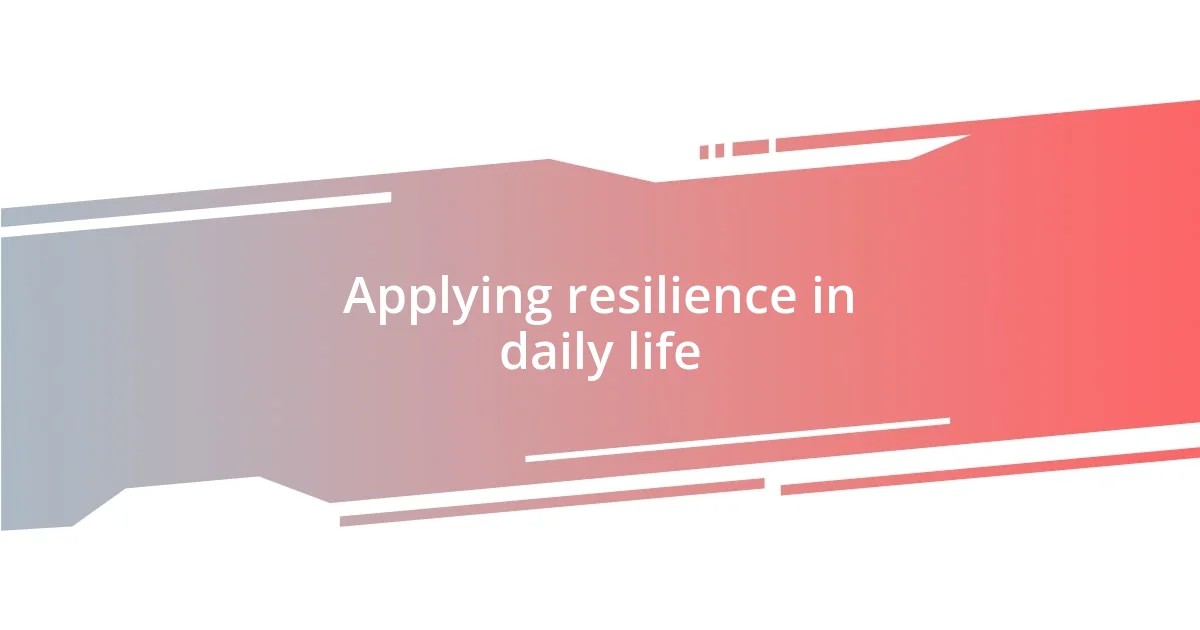
Applying resilience in daily life
Applying resilience in daily life requires a conscious effort to integrate the lessons I’ve learned into my everyday routines. For instance, I’ve started to embrace a morning ritual that’s become a cornerstone of my resilience practice. Each day, I take ten minutes to meditate, focusing on my breath and acknowledging whatever emotions surface. This simple act of mindfulness helps me enter the day with a sense of calm and clarity—like setting a strong foundation before building a house. Have you tried carving out quiet moments for yourself? It really can set the tone for everything that follows.
On days when challenges feel rampant, I lean into the power of positive self-talk. I’ve had moments where self-doubt creeps in, especially before a big presentation or when facing change. Instead of spiraling into anxiety, I remind myself of my past victories. “You’ve overcome tough situations before,” I’ll tell myself, and it’s amazing how quickly this shift in mindset can transform a daunting task into a manageable one. It’s crucial to remember that resilience is often about choosing our response to situations. Wouldn’t you agree that our mindset plays a pivotal role in how we manage life’s ups and downs?
I’ve also found that surrounding myself with supportive people bolsters my resilience. I intentionally reach out to friends or family members who uplift me when I feel low. One evening, after a particularly stressful week, I organized a small gathering. Hearing laughter and sharing stories reminded me that I’m not alone in my struggles. Our connections can be a powerful source of strength. Have you considered the influence of your relationships on your resilience? Building a supportive network can be one of the most effective tools we have at our disposal.

